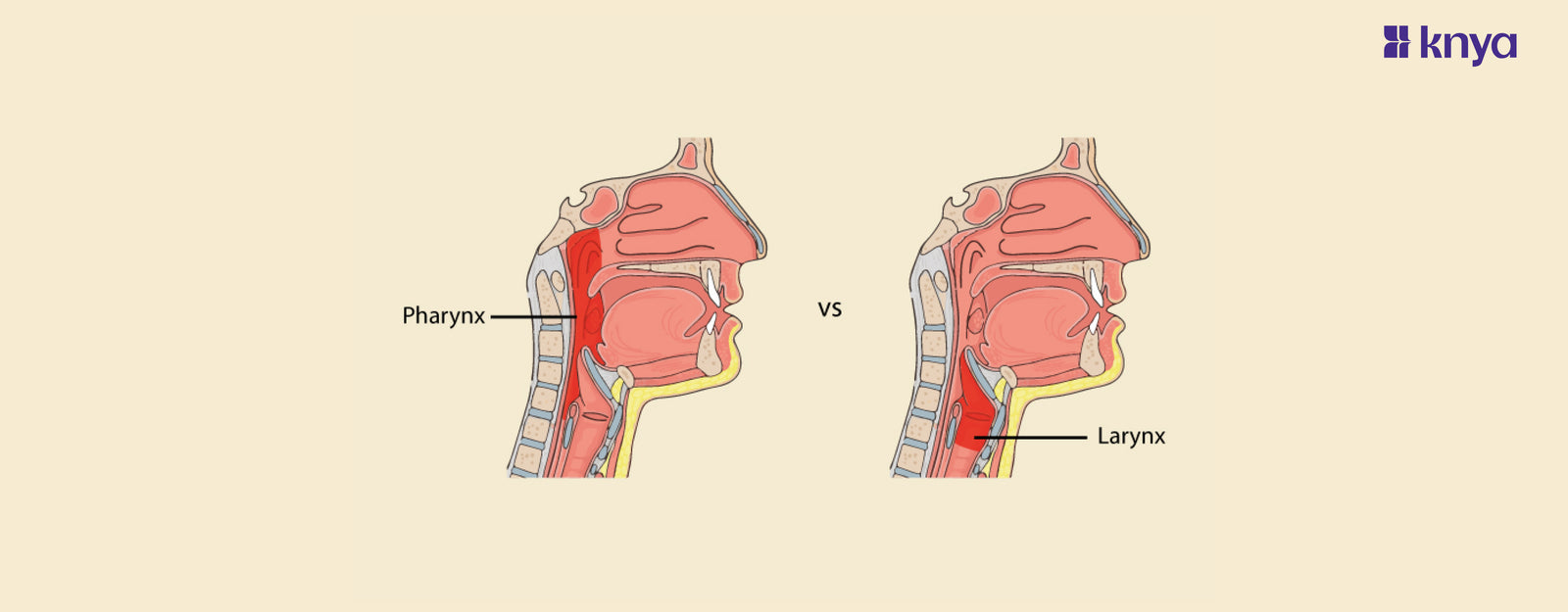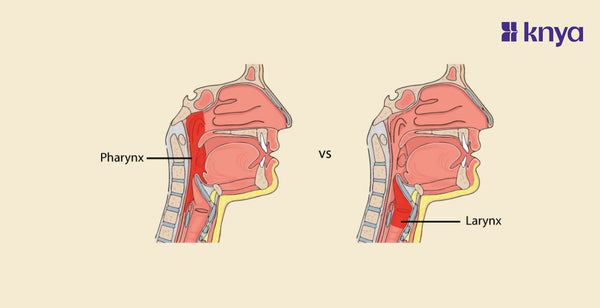Difference Between Pharynx and Larynx: The pharynx and larynx are essential components of the human respiratory and digestive systems, playing distinct roles in the processes of breathing, swallowing, and vocalization. These structures, located in the upper part of the throat, contribute to the intricate orchestration of air and food passage in the human body.
Pharynx:
- The pharynx is a muscular tube situated behind the nasal cavity, mouth, and larynx.
- It serves as a common pathway for both air and food, functioning in both the respiratory and digestive systems.
- Divided into three sections: nasopharynx, oropharynx, and laryngopharynx, each serving specific functions in the overall process of ingestion and respiration.
Larynx:
- Also known as the voice box, the larynx is located just below the pharynx and above the trachea.
- It is primarily responsible for producing sound and facilitating speech.
- Contains vocal cords, which vibrate when air passes through, producing various pitches and tones.
- Plays a crucial role in preventing food and liquids from entering the trachea during swallowing, thanks to the epiglottis.
Difference Between Pharynx and Larynx
Here is a table highlighting the key differences between the Pharynx and Larynx:
|
Characteristic |
Pharynx |
Larynx |
|
Location |
Behind the nasal cavity, mouth, and larynx |
Below the pharynx, above the trachea |
|
Function |
Common pathway for air and food |
Voice production and sound modulation |
|
Divisions |
Nasopharynx, oropharynx, laryngopharynx |
No distinct divisions, but includes vocal cords |
|
Role in Respiration |
Contributes to the respiratory system |
Connects the pharynx to the trachea |
|
Role in Digestion |
Participates in the digestive system |
No direct role in digestion |
|
Structures |
Muscular tube |
Contains vocal cords and the epiglottis |
|
Swallowing Assistance |
Assists in the initial stages of swallowing |
Prevents food and liquids from entering the trachea during swallowing |
What is Pharynx?
The pharynx is a muscular tube-shaped structure located in the throat, behind the nasal cavity and mouth, and extending to the esophagus and larynx. It serves as a crucial anatomical component involved in both the respiratory and digestive systems. The pharynx plays a central role in the passage of air and food, connecting the nasal and oral cavities to the larynx and esophagus, respectively.
The pharynx is divided into three main regions:
- Nasopharynx: The uppermost section of the pharynx, situated behind the nasal cavity. It functions primarily in the passage of air during breathing.
- Oropharynx: Located behind the oral cavity (mouth), the oropharynx is responsible for the passage of both air and food. It serves as a common pathway for the respiratory and digestive systems.
- Laryngopharynx: The lowermost portion of the pharynx, connecting to both the larynx and esophagus. It plays a crucial role in directing food and air to their respective pathways.
What is larynx?
The larynx, commonly known as the voice box, is a cartilaginous structure located in the neck, situated just below the pharynx and above the trachea. It plays a vital role in the production of sound and the modulation of pitch during speech. The primary functions of the larynx include vocalization and protecting the lower respiratory tract during swallowing.
Key features of the larynx include:
- Vocal Cords: The larynx contains two pairs of vocal cords (or vocal folds), which are stretched across its interior. These cords vibrate as air passes through, generating sound waves that are shaped into speech sounds.
- Epiglottis: A flap-like structure in the larynx that helps prevent food and liquids from entering the trachea during swallowing. It covers the trachea, directing substances toward the esophagus and away from the respiratory passages.
- Cartilages: The larynx is composed of several cartilages, including the thyroid cartilage (Adam's apple) and the cricoid cartilage. These structures provide support and protection to the vocal cords.
- Tracheal Connection: The larynx connects the pharynx to the trachea, serving as a transition point for air entering the respiratory system.
The larynx is a crucial anatomical structure that facilitates speech and protects the airway during the complex processes of breathing, swallowing, and vocalization.
Get best quality Lab Coats for Students here!
Similarity Between Pharynx and Larynx
The pharynx and larynx share several similarities, as both are integral components of the upper respiratory and digestive systems. Here are some key similarities:
- Anatomical Location:
- Both the pharynx and larynx are situated in the upper part of the throat.
- Respiratory Function:
- Both structures play roles in the respiratory system, contributing to the passage of air.
- Muscular Composition:
- Both the pharynx and larynx contain muscles that aid in their respective functions.
- Connection to the Respiratory Tract:
- They are interconnected, with the pharynx connecting to the larynx and then to the trachea, forming a continuous pathway for air.
- Involvement in Swallowing:
- Both structures are involved in the initial stages of swallowing. The pharynx directs food and liquids to the esophagus, while the larynx prevents their entry into the trachea.
- Protection of Airway:
- They contribute to the protection of the airway during swallowing. The epiglottis in the larynx covers the trachea to prevent aspiration of food and liquids into the respiratory passages.
- Voice Production:
- While the pharynx is not directly involved in voice production, it contributes to resonance. The larynx, on the other hand, is the primary structure responsible for voice production.
These shared characteristics highlight the interconnected and complementary roles of the pharynx and larynx in facilitating respiratory functions, swallowing, and, in the case of the larynx, vocalization.















